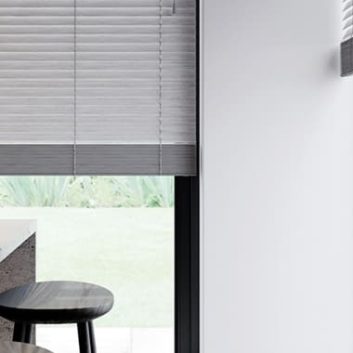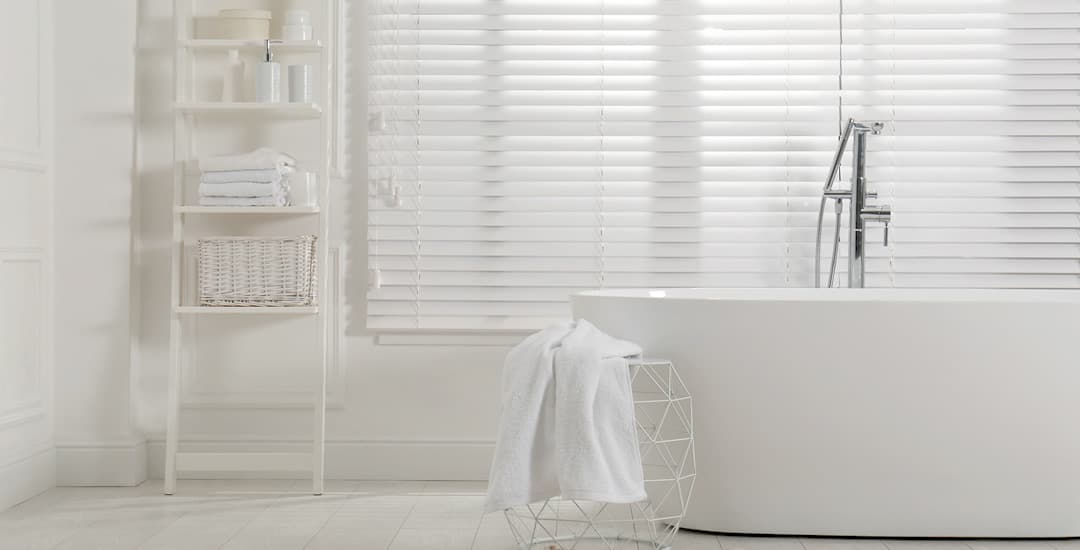
Are faux wood blinds good for bathrooms? Yes, faux wood blinds are one of the best choices for bathroom blinds. Faux wood blinds are waterproof, which is absolutely essential to withstand the rigours of use in a humid or wet environment like a bathroom; but faux wood blinds also have a couple of other things going for them too, which most other waterproof blinds do not.
This blog post will talk about faux wood blinds for bathrooms in more detail, covering why they’re a good choice and whether there are any bathrooms or scenarios that they might not be well suited to as well.
Can you put faux wood blinds in the bathroom?
Yes, faux wood blinds tick all of the boxes for what you need from bathroom blinds, and they’re one of the types of blinds that are completely suitable for this type of application.
Bathroom blinds need to be waterproof, which rules out real wood blinds; in fact, real wood blinds would quite possibly begin to warp, develop watermarks or stains, and even potentially grow mildew if used in a bathroom, unless the bathroom in question was large and very well ventilated, and with the blinds a long way from any sources of water.
Why are faux wood blinds good for bathrooms?
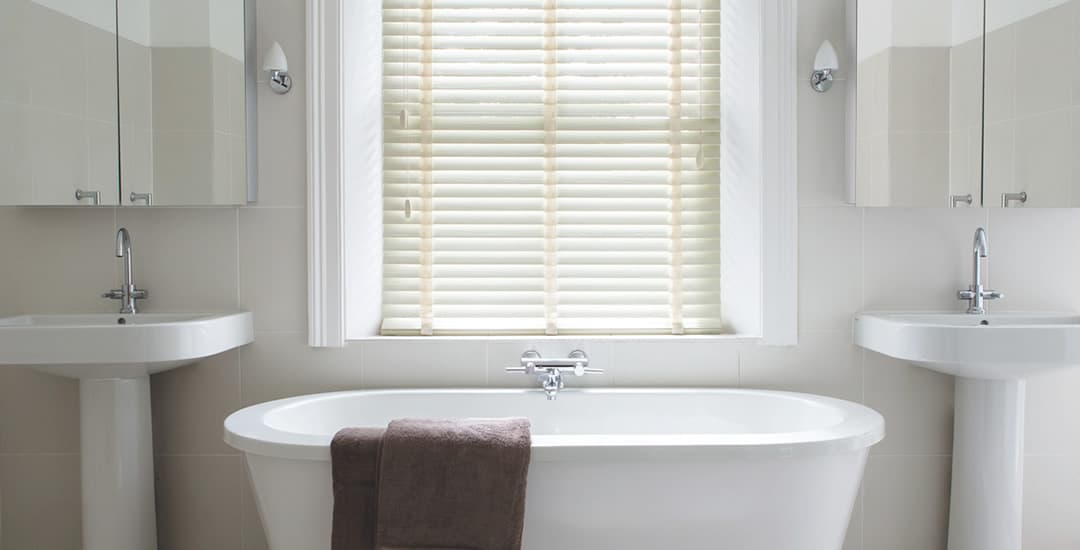
The most obvious reason for why faux wood blinds are suitable for bathrooms is the fact that they’re waterproof. They’re constructed of thick, rigid PVC, which can handle any level of steam and humidity in the bathroom, as well as direct contact with water. This also means that they’re easy to wipe or wash clean.
Faux wood blinds can be produced in a range of different paint colours and natural wood effects, these latter emulating real wood so closely as to be almost indistinguishable from the real thing.
Faux wood blinds are also a couple of shades cheaper than real wood blinds too.
The waterproof side of things isn’t the only reason why faux wood blinds are a good choice for bathrooms, and there are a couple of other points in their favour too; or three points actually, if you have kids.
On top of the waterproof thing, faux wood blinds are dense and solid, which means that when they’re fully closed and particularly when hung inside of the window recess (rather than over it) they provide excellent insulation to the window and so, bathroom as a whole.
You can also adjust their slats with a fine degree of precision to allow you to filter light without blocking it entirely, and/or to enhance or protect your privacy.
If you’re taking a bath or shower or whatever during daylight hours, you might not want to fully close the blind for privacy’s sake at the cost of losing the natural light; with a faux wood blind you can angle the slats to allow you to let light in whilst also keeping the neighbours from getting an eyeful.
Yes, before anyone mentions it, I do get that most bathroom windows are frosted… However, the level of opacity that this results in can be variable, and potentially not sufficient on its own, particularly if your bathroom is very closely overlooked by neighbours or passers-by.
Also, a frosted window is exactly as much use as chocolate teapot in terms of hiding your nudey bits if the window is open to allow some air in during the summer, or some steam out at any time of the year if your bathroom’s steam extraction system is heavily supported by or in fact, consists of, opening a window.
I did also mention that there is a third reason over and above the whole waterproof thing to be said for faux wood bathroom blinds if you have children; and this is that faux wood blinds are very hardwearing.
This might not be of any relevance if your children are older and/or not prone to random bouts of either planned or inadvertent destruction, but a faux-wood blind will withstand more or less any amount of being hit with plastic bath toys, being shot with water-propelled projectiles, and the odd poorly aimed slide-launched Hot Wheels car too.
Do you really need waterproof bathroom blinds?
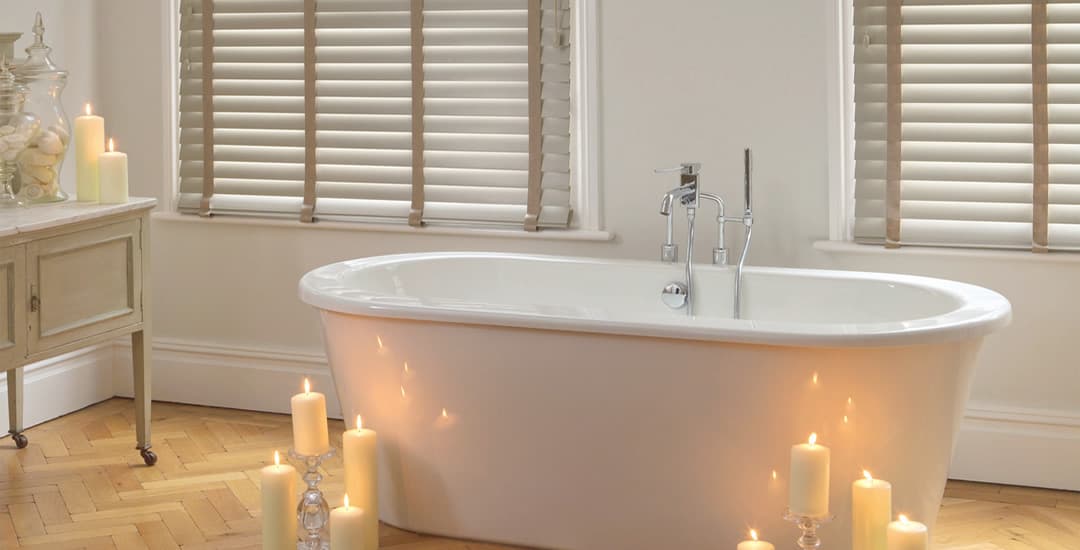
The main or most integral point of choosing faux wood blinds for bathrooms is that they’re waterproof; but do you really need waterproof bathroom blinds if, say, the blinds are never going to come into direct contact with water?
This is still a “yes” for most bathrooms, because humidity/steam/potential damp and so on all have an impact on non-waterproof or splashproof bathroom blinds, and it’s never a good one.
Whether a blind is made of either a non-waterproof fabric or an alternative porous material (like wood), they absorb water and droplets of steam, and ultimately, this compromises both the cosmetic appearance of the blind and eventually, how well it works too.
When I say “eventually,” by the way, any good quality made to measure blind should last around a decade in good working order when used in the appropriate environment; but using a non-waterproof blind in a bathroom is apt to result in the blind looking shabby and failing to work properly (if at all) in many potential ways within just a few years.
This means that Roman blinds, wooden blinds, non-waterproof roller blinds, non-waterproof vertical blinds, and day and night blinds are not a sensible choice for bathrooms. Venetian blinds (made of painted aluminium slats with fabric lift cords or tapes) are borderline; you can get away with them in a dry and well-ventilated bathroom as the slats are waterproof, but the cords suspending said slats are not, which can become a problem.
So the short answer is yes, you do really need waterproof blinds for bathrooms in the vast majority of cases, and non-waterproof or theoretically “splashproof” bathroom blinds won’t cut it.
Are faux wood blinds good for bathrooms with very large windows?
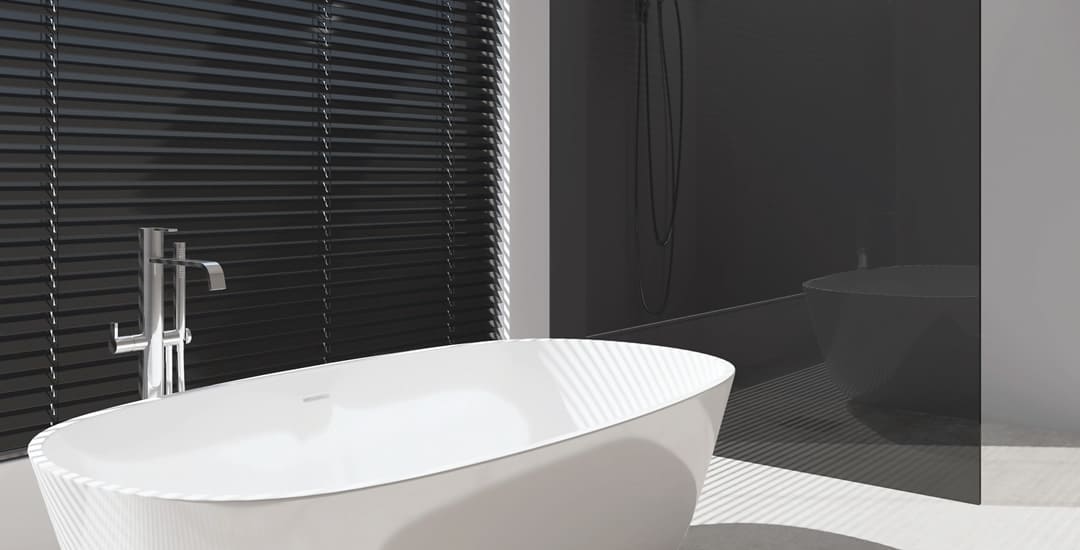
In closing, one tiny caveat to add to the faux wood bathroom blinds love-in, and in explanation to this seemingly very specific question: are faux wood blinds good for bathrooms with very large windows?
Probably not.
Faux wood blinds are one of the heavier types of blinds you can get, which means that they top out in terms of the height or width or overall dimensions they can be made in before other, lighter blinds do.
This is for reasons ranging from the difficulty and cost of shipping really heavy blinds, the safety and practicality aspect of people being able to hang them successfully and without risking injury, and even the structural integrity/maximum load weight of the walls of some homes… Not to mention the fact that even just operating a blind that weighs a tonne in terms of opening and closing it will be outside of the physical capabilities of most people who don’t spend more time in the gym than Popeye.
If you want to know exactly the sort of sizes that faux wood bathroom blinds can be made in that we/the average Joe considers to be safe, practical, and functional, well, ours can be ordered in sizes up to a maximum of 260cm wide and 300cm high.
This is, as you may well be thinking, still a pretty large blind, particularly for a bathroom; and so you would need to be working with a really really large window before faux wood blinds need to be discounted as a potential choice.
If this does happen, your other choices of waterproof bathroom blinds (that are also suitable for really big windows) are PVC or vinyl vertical blinds (these being the type of blinds that can be made in the tallest/widest sizes of all), and PVC or vinyl roller blinds.
Venetian blinds are borderline suitable depending on the bathroom because their slats are waterproof but their lift cords are not and so these may be an option too, but they’re not technically 100% waterproof and would not be a good pick for very small or humid bathrooms, or anywhere that they might be at risk of getting splashed.

